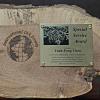Editor's Picks
Plant Focus
Following the destruction of the cathedral of Notre-Dame de Paris by fire in April 2019, the French government decided in July 2020 that it would be rebuilt á l’identique, i.e. as an identical replica of the original. Around 2,000 oaks will be used for the framework of the spire, half to be felled this year and the rest in 2022. Last month, eight Quercus petraea at the Forêt de Bercé in Sarthe, northwest France, were felled. (The IOS visited the forest during the Pre-Conference Tour in 20121.) It has been managed and harvested for centuries, since Louis XIV’s minister Jean-Baptiste Colbert chose it in 1669 to be a source for wood to build warships. Oaks were planted among beeches, at a ratio of three beeches to one oak, so that the oaks, playing catch up with the faster growing beeches, would grow straight and produce trunks of the appropriate shape for ship building. After a time, ships were no longer built of wood, yet the trees continued to grow. When architects started searching for oaks of the shape they needed for the reconstruction project, the tall, slightly tapered boles of the oaks at Bercé checked all their boxes. With the help of drone footage, eight trees were selected and later felled in front of an invited audience of journalists.
|
Video of oak being felled at Bercé (in French). Translation of titles: |
The decision to topple 230-year-old trees to rebuild Notre-Dame has not been uncontroversial. A petition to stop the felling, which it described as “ecocide”, has received over 42,000 signatures. French foresters described this as “le reflex Idéfix” ("the Dogmatix reflex") in reference to a well-known cartoon character in the Asterix comic books by Goscinny and Uderzo: Dogmatix is the terrier who howls inconsolably whenever a tree is harmed. Similar reactions could be found on social media, with some calling for steel or concrete to be used instead, as a more environmentally friendly solution. It is tempting to think that by sparing centuries-old trees and using steel and concrete in their place the environment would be better off. However, more detailed analysis shows this is not the case.

Making steel and concrete generates around 8% of the world’s anthropogenic carbon-dioxide emissions. Architects are in fact looking to using wood to construct skyscrapers as a way of reducing emissions and even extracting carbon from the atmosphere. At a meeting of the American Association for the Advancement of Science in February, Michael Ramage of the University of Cambridge described a 300-square-meter four-story wooden building constructed in that city. Had it been made with concrete, it would have generated 310 tons of C02; if it had been made with steel, emissions would have exceeded 498 tons. Using wood instead lowered emissions to 126 tons. And you could even argue that the building was “carbon negative”. Trees lock up carbon in their wood. If this wood is then used in a construction, the carbon is in effect stored for centuries rather than recycled by beetles, fungi, and bacteria and released back into the atmosphere. The wood used to construct the building in Cambridge locked up the equivalent of 540 tons of CO2, thus implying a long-term net subtraction from the atmosphere. If wood replaces steel and concrete as our principal building materials, will there be enough of it to supply our needs? Probably: Dr. Ramage estimates that in just seven seconds Europe’s sustainable forests grow the 30 cubic meters of timber required to build a family-sized apartment.
The Forest of Bercé is one of these managed, sustainable forests, so using some of its wood to reconstruct Notre-Dame makes ecological sense. Trees are harvested every year, whether a cathedral is being reconstructed or not. The 1,000 oaks felled for Notre-Dame this year represent 0,1 % percent of the annual harvest. Half of the oaks will be sourced from state forests, with the remainder being donated by private landowners from their forests. When these oaks are removed, they will make room for new ones that will continue to lock up carbon. The eco-friendly argument would of course collapse should the reconstructed cathedral again go up in smoke, so let’s hope steps are being taken to ensure this does not happen.
|
In the video above watch a forester and landowner select an oak that will be used to reconstruct the spire at Notre-Dame (in French). Summary of content: |
Further reading
Building sustainable cities with wooden skyscrapers. The Economist, February 2021.















